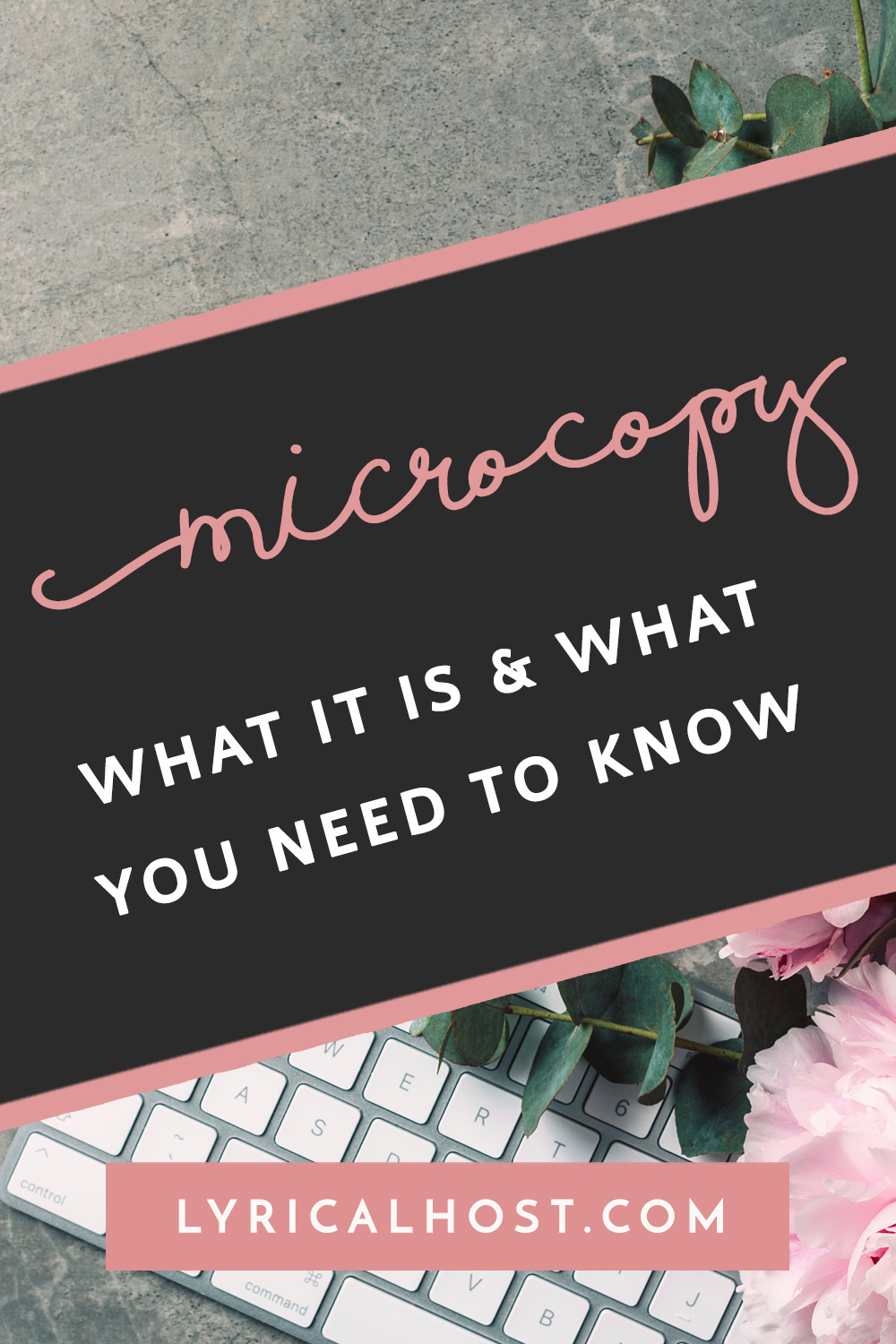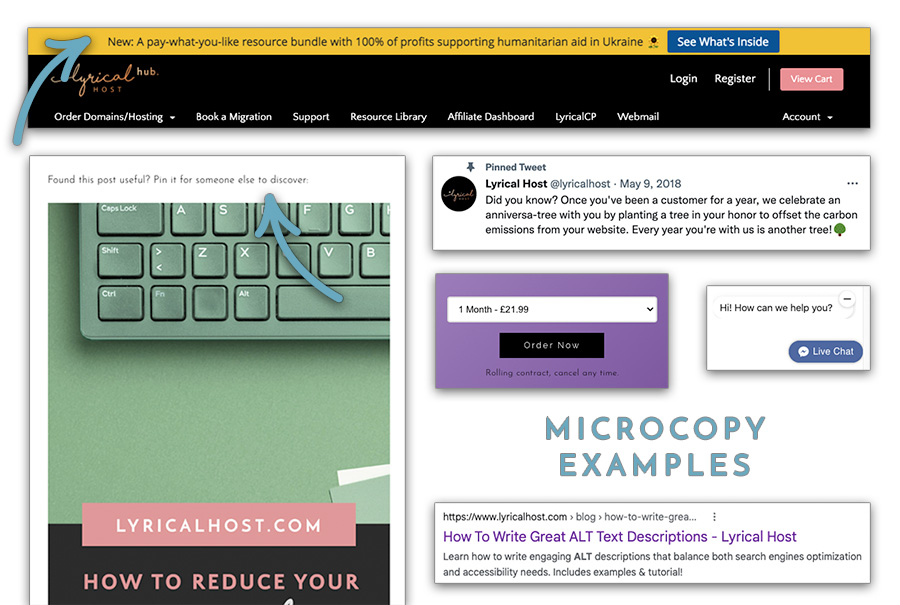In this post we look at what to consider when you’re writing deliberately short snippets of text for the web, including when to use them and how to make them super effective.
Currently reading: What Is Microcopy? A Guide (& Tips) For Bloggers & Businesses Click To TweetWhat is microcopy?
Microcopy is a deliberately short amount of text that can appear offline or online. Examples of microcopy include, but aren’t limited to, straplines, tweets, email subject lines, call to action buttons or voiceovers, meta descriptions, ALT attributes, subscription or order confirmations, advert text, and short-form product or service descriptions.
A common mistake people make is to see “copy” in and of itself as just “text on a web page.” Copy is specifically about convincing someone to do something, whether that’s clicking through to a web page, buying a product or service, subscribing to an email list, following you on social media, or similar. Although copy and microcopy can often appear in blog posts, especially ones that include affiliate links or other calls to action, it’s more likely that blog posts and articles fall into the web content/author family rather than copy.
Online, microcopy specifically also often has closer ties to web design & development and user experience than regular copy does. This is because microcopy is very often accompanied by an actionable feature on a web page such as clicking a button, navigating a menu, completing an order, publishing a post or comment, and so on.
Microcopy examples
One of the best ways to understand different types of microcopy is to see some examples in context. Below we’ve included a meta description as displayed in Google search results, a tweet, a text call to action in a blog post, a button, a chat box intro, and a pop up bar on a website. You can click to enlarge the image.
From these examples you can see how microcopy is extremely well-adapted to a variety of different formats. It’s not explicitly defined by a specific medium, more so by its purpose in encouraging action.
What makes good microcopy?
If you have a website or social media account of any kind, it’s extremely likely you’ve already been writing microcopy even if you didn’t realize it! The good news is that you don’t have to be a professional advertising exec or great smart puns or jingles to create great copy. The best copy is copy that converts.
Microcopy should always be an aid rather than a distraction. You don’t want text on your page that doesn’t serve a purpose or makes it harder for the visitor to complete the action you want.
As microcopy by its very nature is short and usually serves a direct purpose, if you’re in control of the styling then it’s something you need to consciously check to ensure good user experience and accessibility. For example, microcopy appearing on an image should also appear in the image’s ALT attribute. Any clickable text should also not be so short as to make things difficult for the user, for example “FB” as a link is harder to click or tap than “Facebook” as it requires more manual dexterity.
Similarly to all copy, microcopy also requires thinking about and balancing the purpose beyond the words. You’re signposting something for your reader, but why? Consider:
- What is your goal in crafting this copy?
- How can you make life as easy as possible for your visitor?
- How can you make your instructions crystal clear, with no ambiguity?
- What will convince your visitor to complete the action you’re asking for?
Figuring out if your microcopy is working in the real world is something we cover in more detail later on in this post.
The pros and pitfalls of microcopy
In a world where people usually scan and skim online, microcopy is very effective as it leans into this notion. You’re often not telling a story or trying to build up to something within the text itself, it’s very much a “does what it says on the tin” scenario. Your words, links, or other content, such as video before or after your microcopy do all the heavy lifting in that respect.
As much as this can be an advantage, it can also be a disadvantage because there’s a fine line between refining your microcopy and overthinking it.
If you’re wordy, sometimes it’s really hard to cut down the number of words or characters you’re using to make your point (harder than writing them in the first place!). Sometimes drafting your copy within Twitter – or another platform/software option where character limits are very visible) can help you stay consciously aware of length.
Sometimes it can get to the point where you’ve stared at a word for so long it starts to look strange. This is often a sign of overthinking or spending too much time on a piece of copy – in which case, take a break and come back to it later. You could always ask a contact to look at it in the meantime.
Visitor feedback can also be useful. If someone misunderstands what your copy means, it’s worth going back to the drawing board and changing it. While the opinion or experience of one person doesn’t always reflect the masses, it’s always important to take their feedback and look at how that experience came about. This is especially true where your copy may have legal implications, for example explaining what someone is buying or the terms of that.
Two tools to help you write better microcopy are HemingwayApp.com and Grammarly.com.
Writing standalone microcopy vs. using it with long form copy
The tone of your microcopy will often be guided by your brand (e.g. whether you’re normally jokey, formal, fun, friendly etc.), but it will also be heavily influenced by the context. For example, if you’re writing a one-liner, you may want it to be a clever pun or rhyme so it’s memorable. If you’re writing the text for a button, practicality and usefulness win out.
Where your microcopy has to stand on its own – or maybe even compete, e.g. with other tweets – it needs to convey all the required information within itself as there’s no supporting text or content to help it. This may also happen where there’s other content or text being displayed at the same time, but it’s unrelated to or has a different goal from the microcopy (e.g. a blog post with a box that asks you to subscribe to a newsletter). In this situation your goal is to convey exactly the right amount of information – not too much it’s distracting, but not so little it creates confusion or gets overlooked.
When you’re using microcopy alongside longer form copy, your microcopy should complement and work toward the overall goal (e.g. convincing someone to subscribe, buy, or contact you). It doesn’t necessarily mean you have to match the tone; in some cases, microcopy that is very different can help it stand out from the rest of the page. It can be worth testing both ways.
The challenge in this situation is making sure the microcopy doesn’t get lost in the rest of the page. This is most commonly avoided with design or stylistic features such as outlined boxes, pop ups, different colored sections or buttons, bolding text, accompanying images (e.g. an envelope to highlight subscribing to emails), more spacing, and so on. It can also stand out by the nature of being very short copy compared to the longer paragraphs surrounding it.
Where your reader/consumer is in the process is likely to determine the type of microcopy you want to use. For example, if your visitor is ready to buy and just wants to hit a button, something very short that aids them in getting to checkout or placing their order is all you need. On the other hand, if all they’ve seen from you so far is a random tweet and they’re unfamiliar with you, your microcopy needs to do more hand-holding and work harder. It will have more importance earlier on in the selling process.
How to figure out if your microcopy is working
As microcopy is very short by definition, that makes it a good candidate for A/B testing (testing one variation against another to see which performs best).
“Good” microcopy is only good if it converts; whether it sounds clever or snappy to someone is great, but that doesn’t always correlate with how successful it is. For that reason, if you’re working as part of a team, try to avoid making decisions solely based on what the alpha person’s opinion is, and try to use data (or plan to test different alternatives and look at the results instead).
As microcopy is often used alongside or as part of a feature, be careful in changing too many things at once that may affect your results. For example, if you’re testing whether “Learn More” or “Buy Now” is more effective button text for your audience, don’t also change the color of the button, font, size etc. at the same time. Test the copy separately to the stylistic elements and build your way up to the best combo.
If you’re a solo blogger or business owner, you likely don’t have the time to be testing every single bit of microcopy you use or create. For that reason, we’d recommend only working on improving copy that’s super important to you (e.g. it’s fundamental to your visitor/goals/services, or it’s going to be prominently positioned on your site for a long time.
Offering microcopy as a service
Adding microcopy to your service offerings is a great way to show you understand the importance of the context you’re working in and can set you apart from the competition. As it crosses over into so many different areas, it’s a great sell for web designers, developers, UX and UI experts, social media strategists and implementers, VAs (virtual assistants), PPC/advertising specialists, and of course copywriters.
How you position your service will depend on how it can fit in with your current offerings, and what goals your clients typically have. As good microcopy is essential for good conversions, it’s a very attractive prospect to clients to have you offer it as a specialty.
Want to come back to this post later or share it to help someone else? Pin it:








No Comments